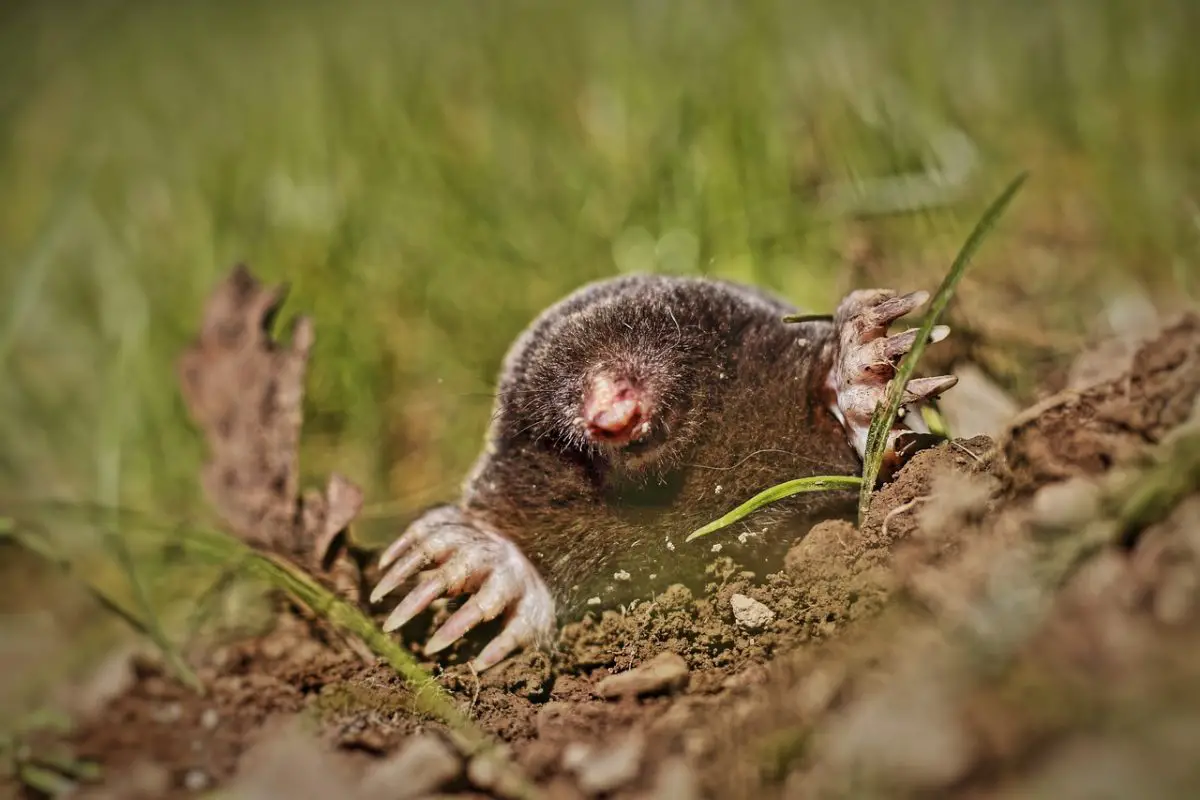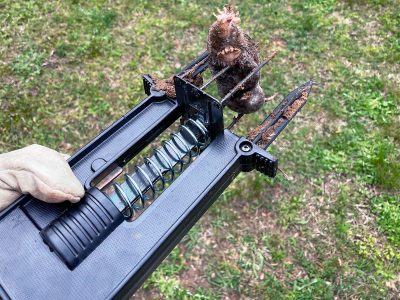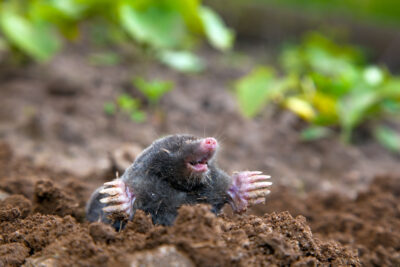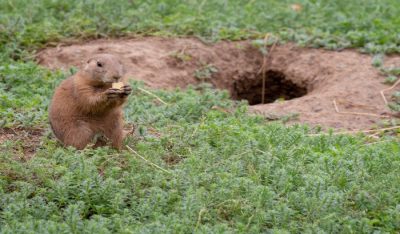If you’ve discovered holes, wilted plants, or mounds of dirt disrupting your lawn or garden, you’re likely dealing with underground pests. Gophers and moles are common culprits that can cause significant damage to your property. Though they share some similarities, identifying gopher vs mole is crucial for implementing effective control measures.

Gophers are herbivores that primarily consume plant roots and vegetation, causing plants to wilt and die. They create distinctive crescent or fan-shaped soil mounds with plugged entrance holes. Moles are primarily insectivores that feed on earthworms and grubs, creating cone-shaped “volcano” mounds with a central hole and raised ridges along their tunnels. Their distinct physical characteristics and damage patterns are your best clues for proper identification.
Physical Differences Between Gophers vs Moles

| Characteristic | Gopher | Mole |
|---|---|---|
| Size & Weight |
|
|
| Head & Face |
|
|
| Teeth | Prominent yellow front incisors that protrude from mouth | Small, sharp teeth not visible from outside |
| Front Limbs | Strong claws adapted for digging | Distinctive, broad “paddle-like” feet with extra thumb and long claws |
| Fur | Varies from yellowish-brown to black; lighter underside | Soft, velvety fur ranging from gray to brown, sometimes with silver tint |
Tunneling and Mound Differences
Gophers produce coarser soil mounds that are “dune-, fan-, or bean-shaped with a visible plug,” while moles create “evenly conical mounds without any plug.”

Gopher Mounds
- Fan or crescent-shaped mounds
- Plugged entrance on one side
- Soil is finely textured
- Mounds occur in a line following tunnel
- Deeper tunnels (6-18 inches underground)

Mole Mounds
- Cone or volcano-shaped mounds
- Center entrance hole
- Soil contains clumps/chunks
- Random mound distribution
- Shallow tunnels (3-12 inches underground)

Territory Size
- Gopher: 200-2,000 square feet
- Mole: Up to 1-2 acres (80,000 sq ft)
- Gopher: Up to 200 mounds annually
- Mole: Creates raised ridges from surface tunnels
- Both: Extensive tunnel networks
Diet and Damage Patterns
| Characteristic | Gopher | Mole |
|---|---|---|
| Diet |
|
|
| Plant Damage |
|
|
| Lawn Damage | Discrete mounds of soil with surrounding healthy grass | Raised ridges across lawn and volcano-like mounds |
| Activity Pattern | Active year-round, primarily during day | Active year-round, peak activity in spring and fall |
| Population Density | Higher – up to 60 per acre in ideal conditions | Lower – typically only 2-3 per acre |
To determine whether you have gophers or moles, look at what’s being damaged. If plants are wilting or disappearing without surface disturbance, you likely have gophers. If your main issue is raised soil ridges across your lawn but plants remain healthy, moles are the probable culprit. Moles inadvertently damage plants through their tunneling, while gophers deliberately consume plant material.
Effective Control Methods for Gophers
Physical Barriers
Install underground fencing with 1/4-inch or smaller wire mesh at least 2 feet deep with an outward-facing 6-inch bottom edge to prevent gophers from digging under. This is particularly effective for protecting garden beds and small areas.
Baiting
Apply gopher bait directly into main tunnels, not surface runways. Effective baits include those containing zinc phosphide or strychnine. Always follow label instructions carefully and keep bait away from pets and children.
Trapping
Use specialized gopher traps placed in main tunnels. Locate the main tunnel with a probe, then set traps in pairs facing opposite directions. Check and reset traps daily until no new mounds appear.
Gopher-Resistant Planting
- Gopher-resistant bulbs: Daffodils, narcissus, and alliums contain compounds that deter gophers.
- Repellent plants: Castor bean, lavender, rosemary, sage, and marigolds may help deter gophers when planted throughout the garden.
- Thorny plants: Plants with prickly stems or leaves like euphorbias may discourage gopher activity.
- Plant protection: Surround vulnerable plants with wire mesh baskets when planting to protect roots.
Effective Control Methods for Moles
Grub Control
Since moles primarily seek grubs and insects, eliminating these food sources can make your yard less attractive. Apply beneficial nematodes or milky spore to reduce grub populations naturally, or use appropriate insecticides following label instructions.
Baiting
Use mole-specific baits that resemble their natural food sources, such as artificial earthworm baits containing bromethalin. Place baits directly in active tunnels, identified by pressing down a small section and checking if it’s raised again within 24 hours.
Trapping
Specialized mole traps like scissors-type, harpoon, or choker-loop traps can be effective when placed in active tunnels. Place traps in straight tunnel sections and check daily. Reset or relocate if no activity is observed within 2-3 days.
Castor oil-based repellents can be effective against moles. These products don’t kill moles but make your soil and the grubs within it unpalatable. Mix 3 tablespoons of castor oil and 1 tablespoon of liquid dish soap in 1 gallon of water, then use it to spray areas with mole activity. Commercial castor oil-based repellents are also available.
Gopher vs Mole – Effectiveness of Control Methods
| Control Method | Effectiveness for Gophers | Effectiveness for Moles |
|---|---|---|
| Trapping | High (70-90% success rate) | Moderate to High (60-80% success rate) |
| Baiting | Moderate to High (60-80% success rate) | Moderate (50-70% success rate) |
| Exclusion Barriers | High for small areas (80-90% effective) | Moderate (50-70% effective) |
| Repellents | Low to Moderate (30-50% effective) | Low to Moderate (30-60% effective) |
| Sonic Devices | Low (20-30% effective) | Low (20-30% effective) |
| Flooding | Low and temporary (20-30% effective) | Low and temporary (30-40% effective) |
| Natural Predators | Moderate (40-60% effective) | Moderate (40-60% effective) |
When using any chemical control methods (baits, repellents, or poisons), always read and follow label instructions carefully. Keep these products away from children, pets, and non-target wildlife. Consider the potential environmental impact before application, and use protective gear as recommended on the product label.
When to Call a Professional
While DIY methods can be effective for moderate infestations, consider contacting a professional wildlife removal service if:
- You have a severe infestation with numerous active mounds across your property
- DIY methods have failed after 2-3 weeks of consistent application
- You’re uncomfortable handling traps or baits
- The infestation is affecting structural elements like foundations or irrigation systems
- You’re unsure which pest you’re dealing with despite your identification efforts
Professional wildlife control experts have specialized equipment, expertise, and access to more effective control methods that may not be available to homeowners.
Frequently Asked Questions
Are moles or gophers beneficial in any way?
Yes, both animals can provide some ecological benefits. Moles help aerate soil and consume destructive insects and grubs. They can actually improve soil quality over time by mixing organic material and improving drainage.
Gophers also contribute to soil aeration and turnover, bringing deeper nutrients to the surface. In natural (non-landscaped) areas, both animals contribute to ecosystem health, but their damage typically outweighs benefits in maintained landscapes.
How quickly do moles and gophers reproduce?
Gophers typically produce 1-3 litters per year with 5-6 young per litter. Female gophers can reproduce as early as 3 months of age, allowing populations to grow quickly if left unchecked.
Moles generally have only one litter per year with 3-5 young, typically born in spring. Their reproduction rate is slower than gophers, which explains why their population density is lower (usually 2-3 per acre compared to dozens of gophers in the same area).
Will removing one gopher or mole solve my problem?
Not necessarily. If you remove a single animal but don’t address factors making your yard attractive to these pests, new animals will likely move in to take advantage of the vacant territory and available resources.
For long-term control, combine animal removal with habitat modification techniques like reducing food sources, installing barriers, and using repellents to prevent recolonization.
Do ultrasonic repellers actually work against moles and gophers?
Ultrasonic repellers have limited and inconsistent effectiveness against both moles and gophers. Scientific studies have shown minimal long-term success with these devices, as the animals typically acclimate to the sound after an initial avoidance period.
If you choose to try ultrasonic repellers, use them as part of a comprehensive approach that includes other control methods, rather than relying on them as a standalone solution.
Can I just flood the tunnels to get rid of moles or gophers?
Flooding tunnels is rarely effective as a standalone control method. Both moles and gophers can quickly escape to higher tunnels or create emergency exits. Additionally, flooding may damage your lawn or garden more than it harms the pests.
Flooding might temporarily disrupt their activity but rarely eliminates the problem. More targeted approaches like trapping or baiting typically yield better results.
Conclusion
Successfully managing gophers and moles begins with correct identification, as their control methods differ based on their distinct behaviors and food preferences. While gophers primarily damage plants by consuming roots and vegetation, moles cause more indirect damage through their extensive tunneling in search of insects and grubs.
For gopher control, focus on protecting plant roots with barriers and using traps or baits placed in main tunnels. For moles, target their food source by reducing grub populations and use traps placed in active runways. Both pests require persistent effort to manage effectively. Combining multiple control strategies typically yields the best results, especially for larger properties or severe infestations.
Remember that complete eradication may not be realistic or necessary—the goal should be to reduce pest populations to a manageable level where damage becomes minimal. Maintaining vigilance and addressing new activity promptly will help keep your lawn and garden protected from these underground pests.



